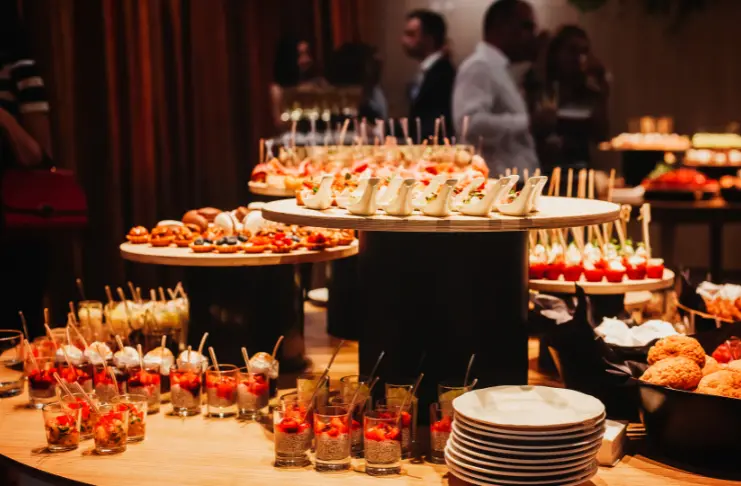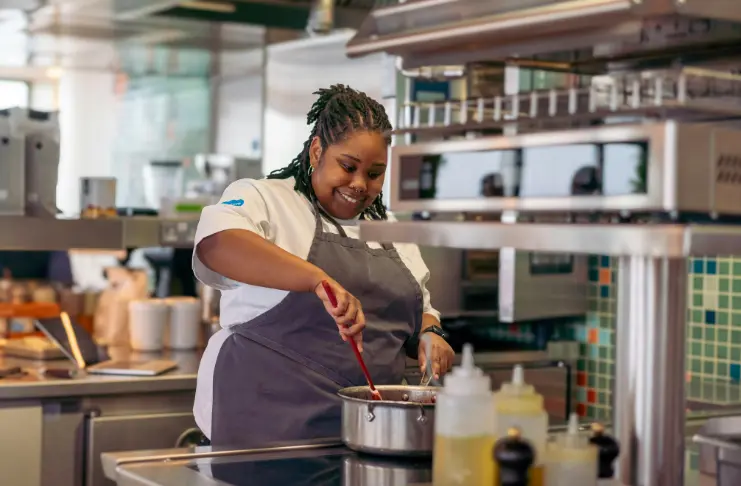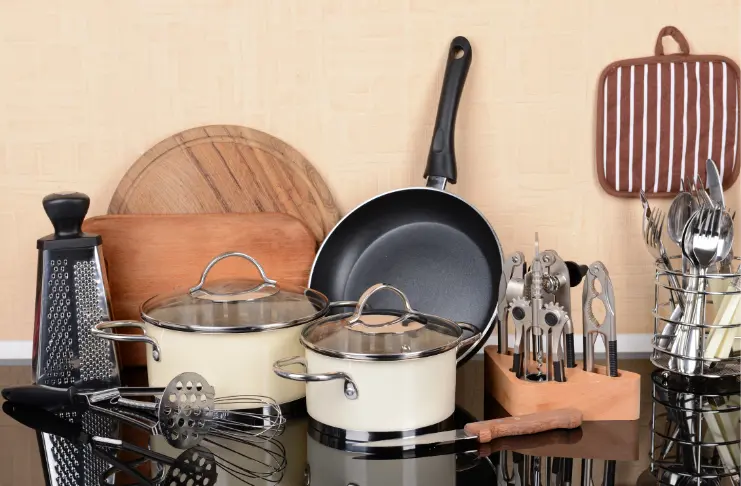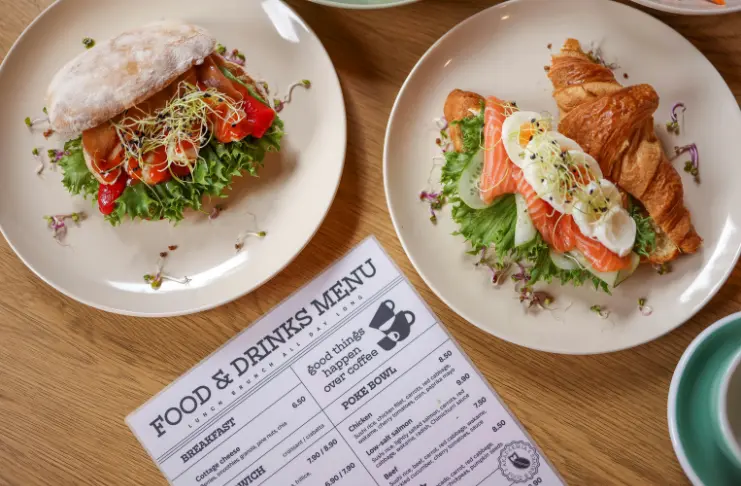The catering business is one of the few segments in the U.S. food industry where demand continues to rise across economic cycles. In fact, its market size is forecast to grow by USD 73.2 billion at a CAGR of 3.7% between 2024 and 2029, making it a stable, high-potential business for food entrepreneurs and chefs alike.
The major appeal of catering lies in its operational format. Unlike traditional restaurants, a catering company benefits from lower fixed costs, a flexible infrastructure, and scalable systems that adapt to diverse event types and client expectations.
Nevertheless, succeeding in this space requires more than culinary talent. It demands strategic planning, regulatory compliance, logistical precision, and consistent client management.
So, how to start a food catering business and gain an edge in the market? This guide covers it all.
Understanding the US Catering Business Landscape

The first step in starting any business is to understand the market you’re entering. The same goes for catering, which is basically a logistics-intensive, event-driven business model with its own economics. In the U.S., it is split across four dominant verticals:
- Corporate catering for meetings, conferences, and training sessions
- Weddings, anniversaries, and private events
- Institutional catering (schools, hospitals, military contracts)
- Seasonal and cultural celebrations requiring large-batch food service
Each model has a different operational footprint and customer expectations.
How to Start a Food Catering Business? First, Choose a Niche
Catering is not a one-size-fits-all business. Specializing in a particular niche improves operational focus, simplifies licensing, and clarifies your market positioning. Without it, your pricing will become inconsistent, inventory planning inefficient, and customer acquisition a scattershot.
So, to decide and choose your niche:
- Assess Local Demand: Study your geographic area. Is there more potential in corporate hubs or residential zones?
- Evaluate Licensing Requirements: Some niches (like institutional catering) require stricter health inspections and larger-scale kitchens.
- Start Where You Can Operate Legally: If you’re starting from home, social or small-scale corporate catering may be the only legally viable option in your state.
- Build from Strength: You don’t have to master each model. Just pick up a segment, build repeatable systems around it, and expand.
Legal Requirements and Business Licensing

Operating a catering business in the U.S. without the correct licenses is a regulatory liability. Penalties may range from fines to forced shutdowns. Though the requirements vary by state and county, the core legal framework remains consistent.
Business Structure & Registration
- Legal Entity: Register your business as an LLC or corporation for liability protection. Sole proprietorships are not recommended due to personal risk exposure.
- EIN: Apply for an Employer Identification Number for tax filing and employee onboarding.
- DBA (if applicable): If operating under a trade name, register a “Doing Business As” (DBA) with your state.
Catering-Specific Permits
You cannot operate without approval from your local health department. This includes passing a kitchen inspection and meeting all food safety protocols outlined in the FDA Food Code.
At a minimum, you’ll need:
- Food Service License – Required to prepare and serve food commercially.
- Catering License – Some states require this as a separate endorsement.
- Health Department Inspection – Covers your production facility, not just event sites.
Home kitchens are rarely eligible for full-scale catering approval. In most states, food must be prepared in a licensed commercial or commissary kitchen.
Local Zoning and Site Compliance
Verify that your business address—whether kitchen or office—is approved for commercial food operations. Zoning laws differ by municipality. You may also need fire department clearance for mobile or temporary setups if you cook on-site at events.
Liability and Insurance
- General Liability Insurance: This covers bodily injury or property damage. It is extremely important for client contracts and venue partnerships.
- Product Liability Insurance: Protects against claims related to foodborne illness or contamination.
- Workers’ Compensation Insurance: Mandatory if you hire employees, even part-time.
Keep in mind that licensing requires annual renewals and compliance updates. Track expiration dates and retain all documentation in case of an audit or client request.
Setting Up Your Commercial Kitchen

A kitchen is the engine of your catering operations, and therefore, it must be licensed, equipped for volume, and compliant with local health codes.
Option 1: Leasing Time in a Commissary Kitchen
For new catering businesses with limited startup capital, commissary kitchens provide an ideal entry point into the industry. These shared commercial facilities offer fully equipped, health department-approved spaces for hourly or monthly rentals.
The best thing about these kitchens is that they reduce startup costs and shift fixed expenses like utilities, cleaning, and waste disposal into variables that scale with your business. During slow seasons, you can reduce your scheduled hours and corresponding expenses.
Plus, you’ll benefit from shared costs for utilities, waste management, grease trap maintenance, and other operational necessities that would otherwise fall entirely on your business.
Option 2: Converting an Existing Commercial Space
As your catering business grows, converting an existing commercial space into a dedicated kitchen becomes more viable. This approach offers more autonomy without the full expense of building from scratch.
The conversion process typically requires coordination with multiple regulatory authorities. In addition to health department approval, you’ll need building permits, fire safety inspections, and possibly environmental reviews for waste management systems.
Budget for architectural drawings, contractor work, equipment purchases, and most importantly, a contingency fund for unexpected compliance requirements that may inevitably arise during inspections.
Option 3: Building a Custom Catering Facility
For high-volume businesses with stable contracts, a purpose-built kitchen delivers maximum efficiency. These spaces are built to reduce labor needs and increase output consistency.
While building a custom facility requires a substantial investment, depending on its size and sophistication, the benefits are multifold. They can produce higher volumes with fewer labor hours, maintain consistent quality standards, and accommodate multiple simultaneous events.
Equipment and Storage Essentials

Unlike restaurants that focus on à la minute cooking, catering operations require equipment that supports production peaks. This makes it all the more important for you to ensure that every square foot and every appliance in your kitchen justifies its presence through efficiency, versatility, or regulatory necessity.
What will you need?
- Combi ovens, tilting skillets, and steam kettles to speed up large-batch cooking
- Blast chillers are essential if you’re holding food before delivery, especially for maintaining HACCP compliance.
- Hot-holding cabinets and insulated transport carts to preserve food temperature during long breaks
- You’ll also need walk-in refrigerators and freezers sized to hold bulk inventory and prepped food ahead of events.
- Include dedicated sinks (handwashing, dishwashing, prep-specific), NSF-certified surfaces, and clear separation zones for raw and cooked items.
- Invest in rolling racks, loading docks, holding cabinets, and delivery vehicles fitted with heating/cooling units.
Consider separate cold storage zones for raw ingredients, finished products, and allergen-specific items.
Allocate room for shelves, racks, and bins that hold dry goods, packaging, disposables, chafing dishes, buffetware, and backup tools.
Include dedicated sinks (handwashing, dishwashing, prep-specific), NSF-certified surfaces, and clear separation zones for raw and cooked items.
Pro Tip: Do not overbuy in the early phase. Invest in modular, stackable equipment. Buy what’s necessary to execute your current menu and meet licensing standards—nothing more. Expansion comes later.
Building a Compliant, Scalable Menu

Your menu will determine your equipment needs, staffing levels, prep timelines, storage requirements, food safety risks, operating costs, and profit margins. That’s why, if it’s not designed for efficiency and scalability, it will break under volume.
1. Start With High-Margin, Low-Labor Items
The most viable catering menus are often “margin-driven.”
- Focus on dishes that travel well, hold their temperature, and require minimal à la minute assembly.
- Avoid last-minute frying, delicate plating, or temperature-sensitive garnishes.
- Prioritize baked pasta trays, grilled protein platters, rice-based entrees, roasted vegetables, and modular sides.
Each item must be profitable, prep-friendly, and transportable.
2. Engineer for Batch Cooking
Catering differs fundamentally from line service. To maximize your menu ROI, standardize recipes in yield units (e.g., 50 servings) to streamline preparation and reduce waste.
Cross-utilize ingredients across multiple dishes, such as using grilled chicken in wraps, bowls, and salads. Pre-schedule production by daypart, with morning hours dedicated to cold prep and the afternoon to cooking and packaging.
Batch-oriented menus reduce labor hours while increasing consistency across orders.
3. Implement Portion Control
Portioning is where profits erode, so eliminate guesswork from your menu creation. Utilize premeasured scoops, portion bags, and digital scales. Create plating guides with visual references for staff.
For buffet catering, calculate consumption rates per head (e.g., 5–6 oz protein, 4 oz starch, 3 oz vegetables per person) and prepare accordingly. Ensure kitchen and packing staff follow exact weights rather than estimates.
4. Build for Event-Type Segmentation
Your menus should align with specific event types: corporate functions, weddings, social gatherings, etc.
For example, corporate events require individually packed meals, dietary options, and a 15–30 minute delivery window tolerance. In fact, 64% of consumers prefer individually packaged meals, and 66% of catering orders include dietary accommodation, making menu flexibility a must for landing corporate contracts.
Weddings, on the other hand, demand multi-course plated or buffet service, time-sensitive hot service, and greater variety. Social gatherings benefit from flexible serving formats, cost-conscious options, and shareable items.
One menu can’t fit all situations, so create modular formats to reduce customization without limiting revenue potential.
INDUSTRY INSIGHT
| As corporate catering scales up, the economics of menu segmentation become clearer. With 32% of companies ordering catering weekly and 53% increasing budgets, only those caterers who tailor their offerings by event type gain repeat contracts, operational efficiency, and margin stability. |
Staffing & Labor Requirements

Catering businesses don’t follow the same labor model as restaurants. You’re not staffing for daily walk-ins but for variable volume, fluctuating timelines, and off-site service. Your labor must be lean, certified, and built for mobility.
At a baseline, your team should include the executive Chef or Kitchen Manager, Prep Cooks / Line Cooks, Delivery and event Staff, and an Event Supervisor (Optional).
Avoid hiring full-time service staff until you have recurring volume. Instead, use a labor pool of part-time or on-call workers trained to your service standard.
Keep in mind that anyone involved in food prep must have valid food handler certification (e.g., ServSafe) to mitigate personal liability. At least one person per shift must hold a manager-level food protection certification, especially in California, New York, and Illinois.
Also, comply with state labor laws on overtime, scheduling, and classification. Misclassifying workers as independent contractors when they follow your schedule and wear your uniform can trigger audits and fines.
Track hours, pay proper overtime, and withhold taxes if they’re employees. Use a W-2 model for regular staff; 1099 only when truly independent.
Delivery, Setup & Execution Logistics
Most catering services fail during delivery. One wrong turn, one late arrival, or a missing chafing rack can collapse the customer experience. Flawless execution depends on tight logistical planning, reliable equipment, and disciplined SOPs.
To ensure timely deliveries, you should:
- Set hard internal deadlines: e.g., “All food packed by 9:00 AM for 10:30 AM drop.”
- If needed, factor in drive time, parking constraints, load-in permissions, and elevator access.
- Use traffic buffer windows. Plan routes with 20–25% time padding, especially during peak hours.
Missed delivery windows may cost you repeat business. So, be careful.
Pricing Strategy & Quoting Models

Choosing a clear and transparent pricing model is non-negotiable when running a business. The most common models include:
- Per-person pricing (PP) – Ideal for weddings, galas, and plated service.
- Tiered Package Pricing—This works well for corporate clients. Packages are priced per head but vary by menu complexity and service level (drop-off vs. full service).
- Flat Fee + Add-ons – Base price for the event plus a menu of a la carte services (bartender, rentals, desserts, etc.). Offers flexibility but requires precise scoping.
Whatever model you choose must consistently cover food costs (target 28–35% of revenue, depending on cuisine), direct labor, delivery and logistics, equipment wear and tear, admin time, and overhead.
Building Client Relationships & Securing Repeat Business
One-and-done catering jobs don’t scale. To grow, you must convert first-time clients into repeat accounts. How?
Focus on Corporate Accounts First
Corporate clients (offices, law firms, agencies, hospitals) offer predictable volume with lower emotional volatility than weddings or private events. They want:
- On-time delivery
- Consistent quality
- Easy invoicing and reordering
To land these accounts:
- Offer standing order options (e.g., every Friday lunch for 50 people).
- Build an account menu—a limited, rotating menu optimized for bulk and ease of execution.
- Be invoice-ready. Offer net terms (7–30 days) if your cash flow allows.
Treat Every Event Like a Sales Pitch
Every delivery is a live demo of your reliability, which is crucial for a successful catering business. Train staff to be on time, professionally dressed, courteous, and silent. Sloppy service kills rebookings, even if the food is excellent.
Always follow up with your clients within 24 hours of delivery.
Use a CRM or Client Tracking System

Track every client’s event type, guest count, preferences, and notes on setup or sensitivities.
This will allow you to personalize outreach (“We loved working with your team at the product launch last month. Would you like us to reserve your May dates in advance?”) and reduce the mental load of remembering clients manually.
Build a Referral Engine
Incentivize past clients, venues, and event planners to refer your business by offering flat referral bonuses or future discounts.
Always carry physical collateral (e.g., menus and promo cards) in your delivery kits. Give clients something tangible to pass on.
Conclusion
Starting a food-catering business in the U.S. demands strategic planning. You’ll need a licensed kitchen, a lean operating model, airtight compliance, and pricing that protects your margins. Your main competitors won’t be other caterers, but logistics, timing, and client expectations.
If you can master planning, cost control, and client retention, you’re bound to run a profitable catering business.
Frequently Asked Questions
1. How profitable is a food-catering business?
Profit margins typically range from 10% to 20%, with higher margins achievable through optimized labor, menu planning, and event pricing. Profitability improves significantly after fixed costs are recovered.
2. How much does it cost to start a catering business?
Startup costs vary by model:
Home-based: $10,000–$25,000
Commissary kitchen: $20,000–$75,000
Full commercial setup: $100,000–$500,000+
3. How to start a catering business from home?
If you wish to start a catering business from home:
– Verify if your state allows home-based food businesses
– Obtain local licenses, a food handler’s permit, and liability insurance
– Set up compliant kitchen equipment
– Start with small private events and scale through referrals
4. Is catering a good business to start?
Yes—low overhead, scalable operations, and rising demand for off-premise dining make catering a strong business, especially in urban and corporate-heavy markets.
5. How profitable is food catering business?
With efficient production and repeat clients, it can generate 6-figure revenues and maintain 10–20% net profits, especially for niche or high-volume event caterers.
6. How to start a food catering business?
To start a food catering business:
– Research your local market and legal requirements
– Register your business and get licensed
– Set up your kitchen (commissary, home, or commercial)
– Build your menu, pricing strategy, and logistics model
– Launch via digital channels, partnerships, or tastings
7. What are the 4 general types of catering?
Four types of catering include:
Corporate catering (meetings, conferences)
Social event catering (weddings, parties)
Concession catering (festivals, sports events)
Private or personal catering (in-home chef services)
8. How much money do I need to start a catering business?
Expect $20,000 to $75,000 for a lean operation and over $100,000 if you’re building a dedicated kitchen and logistics infrastructure.
9. How do I start a food catering business?
Start with market research, business licensing, and kitchen access. Then, build a scalable menu, invest in equipment, market professionally, and deliver consistent service.
10. What license do I need to serve food in California?
You need a Health Permit from your local Environmental Health Department, a business license, a food handler’s card, and potentially a Cottage Food Operation permit if operating from home.
11. How much is a catering license in Illinois?
Costs vary by county, but a Retail Food Establishment License typically ranges from $100 to $1,000+ annually, depending on your business size and location.





